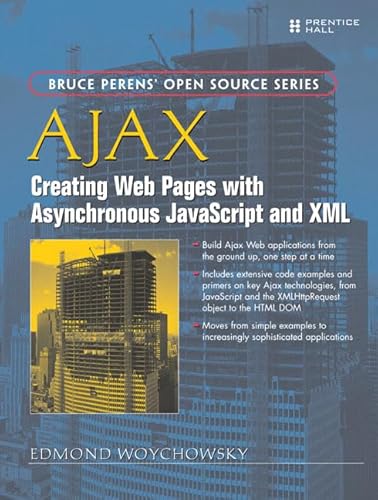
Synopsis
It is powerful, it is open source software, and it works. Ajax has become the tool of choice for many developers using asynchronous JavScript and XML, and master developer Woychowsky uses extensive code examples and primers on key technologies and builds from the ground up so everyone from novices and experts will find this useful. He covers the types of web pages, the basics of Ajax, HTML/XHTML, JavaScript, Ajax using HTML and JavaScript, XML, XMLHttpRequest, Ajax using XML and XMLHttpRequest, Ajax using XSLT, reusing code, exploiting Ruby on Rails and making best use of the essential cross-browser HTML DOM. Annotation ©2006 Book News, Inc., Portland, OR (booknews.com)
"synopsis" may belong to another edition of this title.
About the Author
EDMOND WOYCHOWSKY, a senior level consultant in Pennsylvania and New Jersey, specializes in
client-side JavaScript, Java, Oracle, open source, and Microsoft technologies. A well-known contributor
to TechRepublic, he has developed applications for the financial, pharmaceutical, and manufacturing
industries. He began his professional career at Bell Laboratories.
From the Back Cover
The Easy, Example-Based Guide to Ajax for Every Web Developer
Using Ajax, you can build Web applications with the sophistication and usability of traditional desktop
applications and you can do it using standards and open source software. Now, for the first time,
there's an easy, example-driven guide to Ajax for every Web and open source developer, regardless of
experience.
Edmond Woychowsky begins with simple techniques involving only HTML and basic JavaScript. Then,
one step at a time, he introduces techniques for building increasingly rich applications. Don't worry if
you're not an expert on Ajax's underlying technologies; Woychowsky offers refreshers on them, from
JavaScript to the XMLHttpRequest object. You'll also find multiple open source technologies and open
standards throughout, ranging from Firefox to Ruby and MySQL.
You'll not only learn how to write "functional" code, but also master design patterns for writing rocksolid,
high-performance Ajax applications. You'll also learn how to use frameworks such as Ruby on
Rails to get the job done fast.
- Learn how Ajax works, how it evolved, and what it's good for
- Understand the flow of processing in Ajax applications
- Build Ajax applications with XML and the XMLHttpRequest object
- Integrate back-end code, from PHP to C#
- Use XSLT and XPath, including XPath Axis
- Develop client-side Ajax libraries to support code reuse
- Streamline development with Ruby on Rails and the Ruby programming language
- Use the cross-browser HTML DOM to update parts of a page
- Discover the best Ajax Web resources, including Ajax-capable JavaScript libraries
"About this title" may belong to another edition of this title.
Other Popular Editions of the Same Title
Search results for Ajax: Creating Web Pages With Asynchronous Javascript...
Ajax : Creating Web Pages with Asynchronous JavaScript and XML
Seller: Better World Books, Mishawaka, IN, U.S.A.
Condition: Good. 1st Edition. Used book that is in clean, average condition without any missing pages. Seller Inventory # 9657501-6
AJAX: Creating Web Pages With Asynchronous Javascript and XML
Seller: Anybook.com, Lincoln, United Kingdom
Condition: Good. This is an ex-library book and may have the usual library/used-book markings inside.This book has soft covers. In good all round condition. Please note the Image in this listing is a stock photo and may not match the covers of the actual item,900grams, ISBN:9780132272674. Seller Inventory # 8834684
Buy Used
Quantity: 1 available
Ajax: Creating Web Pages With Asynchronous Javascript And Xml
Seller: Harmonium Books, Philadelphia, PA, U.S.A.
Soft cover. Condition: As New. 1st Edition. Large pbk.; excellent unread condition. Seller Inventory # ABE-1728874657955
Ajax: Creating Web Pages with Asynchronous JavaScript and XML (Bruce Perens Open Source).
Seller: Der-Philo-soph, Viersen, NRW, Germany
Taschenbuch. Condition: Gut. 1. Schönes, innen wie außen sauberes Exemplar!!! Gelesene Ausgabe in gutem, sauberen Zustand. Seiten und Einband sind intakt. Buchrücken und Schutzumschlag können leichte Gebrauchsspuren aufweisen. 384 S. Englisch 999g. Seller Inventory # 555066

